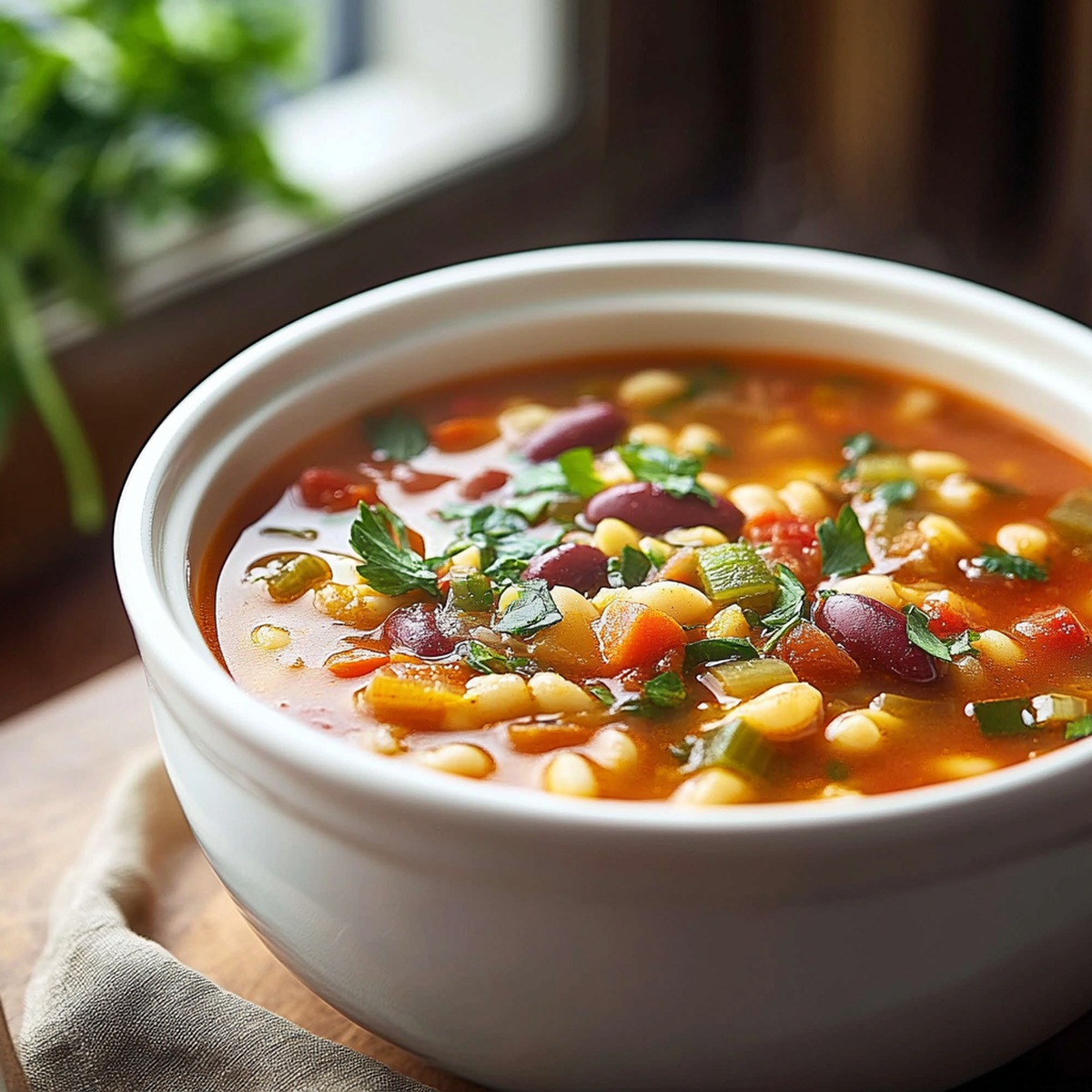Hearty Minestrone Soup Recipe: Cozy Comfort in a Bowl
Crafting a hearty minestrone soup brings comfort and warmth to chilly evenings.
Vegetables dance with beans in this classic Italian classic, creating a symphony of flavors.
Robust ingredients tell a story of rustic countryside cooking.
Mediterranean traditions shine through every spoonful of this nourishing dish.
Fresh herbs and seasonal produce make magic happen in your kitchen.
Rich tomato broth connects you to generations of home cooks.
Dive into this simple yet satisfying recipe that promises to delight your senses and fill your bowl with pure joy.
Tips for Rich Minestrone Soup Flavor
Storing and Reheating Minestrone Soup
Serving Ideas for Minestrone Soup
Exciting Twists on Minestrone Soup
FAQs
Yes, it’s packed with vegetables, beans, and whole grains, providing a nutritious and balanced meal with vitamins, fiber, and protein.
The recipe is already vegetarian. It uses vegetable broth and includes beans for protein, making it a complete plant-based meal.
Cannellini, kidney, or great northern beans are excellent choices. They add texture, protein, and a creamy element to the soup.
Add more beans, use whole wheat pasta, or include additional vegetables like spinach or kale to increase the soup’s nutritional value and satiety.
Minestrone Soup Warmth in Every Spoonful
Key Ingredients for Minestrone Soup
Base Vegetables:Protein and Liquid Base:Herbs and Seasonings:Pasta:How to Cook Minestrone Soup
Step 1: Sizzle Aromatic Vegetables
Heat olive oil in a spacious pot over medium warmth.
Toss in chopped onions, carrots, and celery.
Stir and cook until the vegetables become soft and release their delightful fragrance, which should take around 5 minutes.
Step 2: Layer in Hearty Ingredients
Add minced garlic, diced zucchini, and cubed potatoes to the pot.
Continue cooking and stirring for approximately 3 minutes, allowing the flavors to meld together.
Step 3: Build the Soup Base
Introduce these ingredients to the pot:Bring the mixture to a gentle simmer and let it bubble softly for 15 minutes, developing rich, deep flavors.
Step 4: Cook the Pasta
Slide pasta into the simmering soup.
Cook for 10-12 minutes until the pasta reaches a perfect tender texture.
Step 5: Finish and Serve
Ladle the steaming soup into bowls and sprinkle freshly chopped basil on top.
Serve immediately while piping hot for maximum enjoyment.
Print
Minestrone Soup Recipe
- Total Time: 38 minutes
- Yield: 6 1x
Description
Hearty Italian Minestrone soup brims with garden-fresh vegetables, tender beans, and al dente pasta, creating a comforting melody of flavors. Nourishing and rich with Mediterranean charm, you’ll savor each spoonful of this classic Italian comfort classic.
Ingredients
Vegetables:
- 1 onion, chopped
- 2 carrots, diced
- 2 celery stalks, diced
- 3 garlic cloves, minced
- 1 zucchini, chopped
- 1 potato, diced
Proteins and Canned Ingredients:
- 1 can (14 ounces / 400 grams) diced tomatoes
- 1 can (15 ounces / 425 grams) cannellini beans, drained
Base and Seasonings:
- 1 tablespoon olive oil
- 4 cups (960 milliliters) vegetable broth
- 1 cup (240 milliliters) small pasta (like elbow macaroni)
- 1 teaspoon dried oregano
- Salt and pepper to taste
- Fresh basil, chopped (for garnish)
Instructions
- Warm olive oil in a spacious cooking vessel over moderate flame, introducing diced onions, sliced carrots, and chopped celery. Sauté the vegetables until they become translucent and tender, approximately 5 minutes.
- Incorporate minced garlic, cubed zucchini, and diced potatoes into the vegetable mixture. Continue cooking for an additional 3 minutes, allowing the ingredients to release their aromatic essence.
- Pour in crushed tomatoes, kidney beans, and vegetable broth. Season with dried oregano, salt, and freshly ground black pepper. Elevate the heat to generate a gentle simmer and allow the soup to develop its robust flavors for 15 minutes.
- Gently introduce pasta into the bubbling liquid, stirring to prevent sticking. Reduce heat and let the pasta cook until it reaches a perfect al dente texture, typically 10-12 minutes.
- Once pasta is tender and vegetables are thoroughly cooked, remove from heat. Ladle the steaming soup into serving bowls, creating a vibrant and hearty meal.
- Enhance the presentation by scattering freshly torn basil leaves across the surface, adding a final touch of aromatic freshness before serving.
Notes
- Use fresh, seasonal vegetables for the most vibrant and flavorful soup base.
- Customize the protein by adding pre-cooked diced chicken or keeping it vegetarian with plant-based options.
- Choose small pasta shapes like ditalini or small shells to ensure even cooking and better texture throughout the soup.
- Store leftovers in an airtight container, knowing the pasta will continue to absorb liquid, so you might need to add extra broth when reheating.
- Prep Time: 8 minutes
- Cook Time: 30 minutes
- Category: Lunch, Dinner, Appetizer
- Method: Simmering
- Cuisine: Italian
Nutrition
- Serving Size: 6
- Calories: 160
- Sugar: 3 g
- Sodium: 600 mg
- Fat: 5 g
- Saturated Fat: 0.5 g
- Unsaturated Fat: 4 g
- Trans Fat: 0 g
- Carbohydrates: 27 g
- Fiber: 6 g
- Protein: 6 g
- Cholesterol: 0 mg


Jack Sullivan
Founder & Culinary Storyteller
Expertise
Single-recipe development with a narrative approach, Culinary storytelling and food history, Seasonal and regional ingredient utilization, Home cooking techniques adapted for modern kitchens
Education
New England Culinary Institute (Montpelier, VT)
Certificate in Culinary Arts
Focused on farm-to-table cooking, sustainable practices, and modern plating techniques.
Asheville-Buncombe Technical Community College
Associate Degree in Culinary Arts
Emphasized Southern Appalachian cuisine and local ingredient sourcing.
Jack grew up surrounded by smoky skillets and handwritten recipes in the mountains of North Carolina. His roots in Appalachian cooking shaped the way he sees food – as something that connects people, tells a story, and holds meaning.
With hands-on training and a background in sustainable, regional cooking, Jack started Boil And Broil to make meaningful meals more accessible. He’s all about one-dish recipes that are simple to follow but rich with flavor and history.